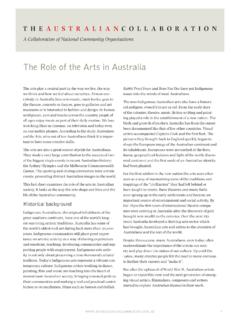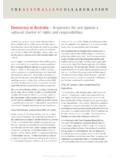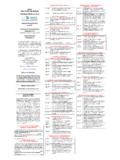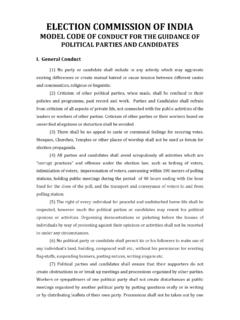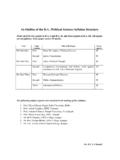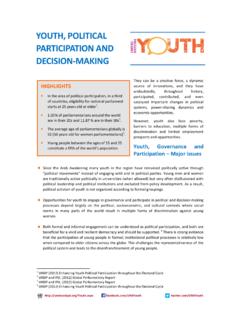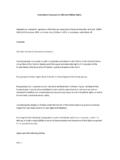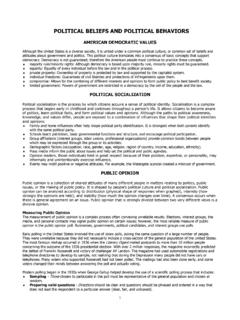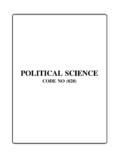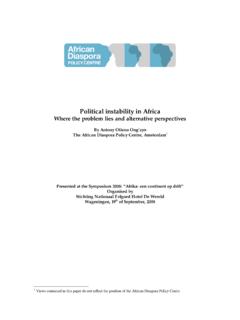Transcription of TheAusTrAl iAnCol lAborATion
1 TheAusTrAliAnCollAborATion is a representative democracy, founded in the liberal democratic tradition. This means that the people vote for candidates from among multiple political parties to represent their interests in parliament; and the deci-sion-making power of elected representatives is subject to the rule of law. The Constitution, together with statute and common law, protects the rights and freedoms of individu-als and minority groups; diverse political interests are acknowledged; and all Australians are entitled to proce-dural fairness in the resolution of sheet explains how power is divided and exercised by parliaments, the courts and the different levels and branches of government in Australia.
2 It also introduces the role of the Australian Constitution and describes the electoral s head of StateQueen Elizabeth II is Australia s nominal head of state, as she is of 14 other sovereign states including Canada and New Zealand. She is represented in Australia by the Gover-nor General. In practice, however, when an appointment of a Governor General is required, the Queen always acts on the advice of the Australian Prime Minister of the day. A similar system applies in the states and the Northern Territory where the Governors and Administrator act as the representatives of the Governor General acts on the advice of the Prime Minister about such matters as the calling of elections.
3 The Governor General only acts independently in extreme situations, such as in 1975 when the Governor General Sir John Robert Kerr very controversially dismissed the Labor government of Gough is a member of the Commonwealth of Nations, a voluntary association of 54 sovereign states formerly associated with the old British Australian federationAustralia has a federal system within which power is primarily divided between the Commonwealth and State and Territory governments. Governments of the states are responsible for all matters not assigned to the Commonwealth in the Australian Constitution, so they play an important and formal part in Australia s political system.
4 In practice the two levels of government cooperate in many areas where states and territories are formally responsible for example in educa-tion, transport, health and law enforcement. The state governments have their own constitutions as well as their own legislatures, bureaucracies, courts and police. While the two territories the Northern Territory and the Australian Capital Territory share many of the attributes and powers of the states, there are important differences. The assemblies in the two territories exercise their powers under legislated delegation from the Commonwealth Par-liament.
5 This means that they are not fully independent and their laws can at times be overridden by the Common-wealth. Furthermore, they do not enjoy all the protections of the government bodies are created by state and territory Council of Australian Governments (COAG) promotes cooperative action on policy reforms among the three lev-els of government: national, state or territory, and Australian ConstitutionThe Constitution sets out the roles and powers of the national parliament, the government and the courts.
6 It guarantees the protection of certain rights and freedoms, defines the responsibilities of the Commonwealth govern-ment (such as foreign relations, trade, defence, immigra-tion and taxation)and places constraints on government in Australia Australia s political systemTheAusTrAliAnCollAborATion Amendments to the Constitution are infrequent, as they are only possible following the approval of the electorate through a national referendum, and the passage of an amendment bill through of powersUnder the Constitution, the federal legislature (the parlia-ment) has the power to make laws, the executive (the gov-ernment) has the power to implement the law and the judiciary (the courts)
7 Has the power to interpret the law. This separation of powers, ensuring that the parliament, the executive and legislature remain independent of each other, is a fundamental aspect of Australia s political sys-tem. It prevents inappropriate interference from any one of these entities in the functioning of the has a legislature based upon the Westminster system of government. The federal parliament comprises two popularly elected chambers: the Senate (or upper house of 76 senators) which includes members from each state in numbers that represent the states equally.
8 And the House of Representatives (or lower house of 150 mem-bers) which includes members from each state in numbers that are proportional to the voting populations of the is formed in the House of Representatives by the party able to command a majority in that chamber, and the leader of that party is appointed by the Governor-General as Prime Minister of Australia. The party or coali-tion with the second largest number of seats in the House of Representatives forms the Opposition. The Leader of the House, a minister appointed by the Prime Minister, is responsible for ensuring that the government s business proceeds efficiently through the House of Representatives.
9 The Speaker, selected by the members from among their own number, runs the House of Representatives according to the standing orders and acts as spokesperson for the House of Representatives in its dealings with the Govern-ment, the Senate, the Governor-General and other no party holds a majority of seats in the House of Repre-sentatives, a hung parliament results, and no party can pass laws without gaining support from other parties or from independent members of the House. In the Senate, the Leader of the Government and the Leader of the Opposition lead their parties in debating proposed laws (known as bills).
10 Although these two sena-tors are responsible for their parties in the Senate, they do not have the same powers as the Prime Minister and the Leader of the Opposition in the House of Representatives. Minority parties often hold the balance of power in the Senate, which serves as a chamber of review for the deci-sions of the government. The President of the Senate is elected by members of the Senate in the same way that the Speaker of the House of Representatives is must be passed by both the House of Representatives and the Senate and be assented to by the Governor-Gen-eral before they can become Acts of parliament.




